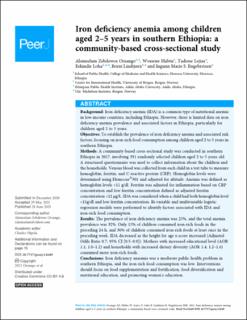Iron deficiency anemia among children aged 2–5 years in southern Ethiopia: a community-based cross-sectional study
Orsango, Alemselam Zebdewos; Habtu, Wossene; Lejisa, Tadesse; Loha, Eskindir; Lindtjørn, Bernt; Engebretsen, Ingunn Marie S.
Journal article, Peer reviewed
Date
2021-06-01Metadata
Show full item recordCollections
- Publications [1497]
Abstract
Background Iron-deficiency anemia (IDA) is a common type of nutritional anemia in low-income countries, including Ethiopia. However, there is limited data on iron deficiency anemia prevalence and associated factors in Ethiopia, particularly for children aged 2 to 5 years.
Objectives To establish the prevalence of iron deficiency anemia and associated risk factors, focusing on iron-rich food consumption among children aged 2 to 5 years in southern Ethiopia.
Methods A community-based cross-sectional study was conducted in southern Ethiopia in 2017, involving 331 randomly selected children aged 2 to 5 years old. A structured questionnaire was used to collect information about the children and the households. Venous blood was collected from each child in a test tube to measure hemoglobin, ferritin, and C-reactive protein (CRP). Hemoglobin levels were determined using Hemocue ® 301 and adjusted for altitude. Anemia was defined as hemoglobin levels <11 g/dl. Ferritin was adjusted for inflammation based on CRP concentration and low ferritin concentration defined as adjusted ferritin concentration <12 µg/L. IDA was considered when a child had both hemoglobin level <11g/dl and low ferritin concentration. Bi-variable and multivariable logistic regression models were performed to identify factors associated with IDA and iron-rich food consumption.
Results The prevalence of iron deficiency anemia was 25%, and the total anemia prevalence was 32%. Only 15% of children consumed iron-rich foods in the preceding 24 h, and 30% of children consumed iron-rich foods at least once in the preceding week. IDA decreased as the height for age z-score increased (Adjusted Odds Ratio 0.7; 95% CI [0.5–0.9]). Mothers with increased educational level (AOR 1.1; 1.0–1.2) and households with increased dietary diversity (AOR 1.4; 1.2–1.6) consumed more iron-rich foods.
Conclusions Iron deficiency anaemia was a
Series
PeerJ vol. 9 no. e11649PeerJ vol. 9 no. e11649
